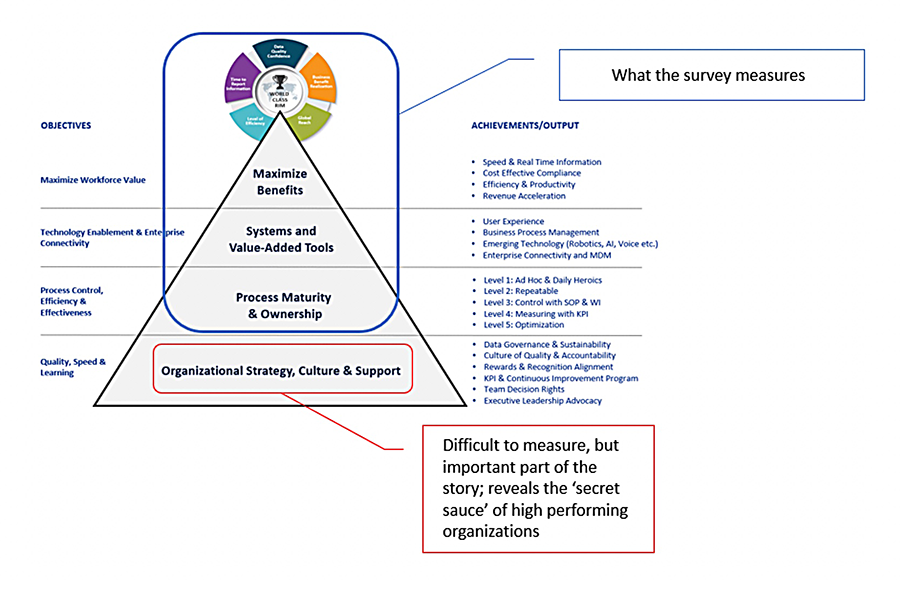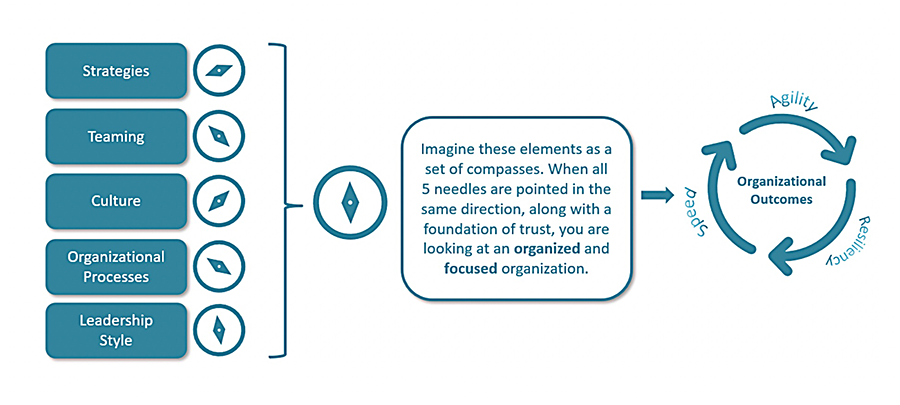Strong Organizational Elements Lead to Strong RIM Performance
By Katherine Yang-Iott
Last month, we reported how the 2020 World Class Regulatory Information Management (RIM)℠ Survey “top performers” have pushed the boulder pass the tipping point in their Global RIM journey. We also shared the critical fact that no correlation exists between top performers to any one particular regulatory solution provider or system strategy; companies with high performance excel on the organizational and process levels.
Our benchmark data doesn’t just measure current industry experience and trends, we also strive to understand the cultural indicators and motivations of organizations, what we are calling the “secret sauce”, that creates the optimal environment needed to support performance improvement for Global RIM programs.
This month, let’s take a look at our updated RIM Performance Framework and explore the critical elements of the organizational layer to better understand the importance of an organization’s “secret sauce”.
The G&A RIM Performance framework identifies 4 connected layers for every organization: The base Organizational Strategy & Culture layer, the Process Maturity & Ownership layer, the Systems & Tools layer, and the Business Benefits layer. The World Class RIM℠ Survey directly measures and quantifies the top three layers, providing an in-depth report for participants allowing their organization to see where they are currently at compared to our World Class performance levels and how they compare with their peers. Based on the data, we also draw conclusions about why they are there. However, the base of the pyramid is asking a structural question of how an organization is setting itself up for success. We believe that a closer examination of the organizational layer can help identify opportunities that create the environment for improving performance.

The Organizational Strategy, Culture and Support layer of our RIM framework focuses on the importance of quality, speed, and learning. Strategies, Teaming, Culture, Organizational Processes, and Leadership Style are 5 critical organizational elements that drive the speed, agility, and resilience in an organization. Alignment between these 5 elements produces the energy needed to direct your organization towards the path to high performance.

Strategies for high performing RIM organizations include the use of continuous improvement programs with key metrics and having dedicated RIM groups. Having data standards and quality governance in place, along with a better understanding of affiliate reporting relationships are also important strategies that positively impacts performance. The benefits of these strategies were confirmed in our 2018 World Class RIM benchmark of 72 companies.
The ‘right’ teaming dynamic is essential for creating an optimal environment. Teams should consist of skills and expertise that fit the needs of the roles, clear decision-making norms with the proper decision rights to take action, a sense of ownership and responsibility for their work, as well as a connection to the overall enterprise. Teaming, done right, allows people to build on and build up trust, which leads to a culture of innovation and learning.
Company culture is everything for an organization: it is who the people are and how they get things done. A culture of innovation and learning describes an agile organization and since markets and regulatory environments are forever changing, it is critically important for organizations to able to learn and self-correct quickly in order to adapt.
Organizational processes are a critical element because having the right ones minimizes risks while ensuring that future challenges will be met with resources needed to overcome those challenges. For your RIM performance journey, align rewards and recognition with data quality, integrate systems and tools that enable progress, and reviewing decision making norms to best empower teams and partnerships are required.
The importance of public leadership advocacy and support was highlighted during our conversations with several top performers, especially those who achieved World Class. They state that leadership advocacy was critical for their success. Leadership style can easily be the main difference between a high performing, smooth operation and that of an unmotivated team within a disjointed function. Effective leadership styles include strong communication skills, promotes team empowerment and psychological safety by having tolerance for those taking informed risks even if unsuccessful. A good leader is someone who shepherds progress while enabling their team.
In our experience, working with over 100 different companies, we believe excelling at the process and organizational levels are the keys to success. These 5 organizational elements will always be shifting but finding this alignment will allow any company to focus on their journey to high performance.
Our framework can help your organization’s RIM performance improvement journey by strengthening your foundations. As always, we are here to help. Contact us with your thoughts and questions. Remember that organizational ‘work’ is complex and takes time, but the payoff will be a stronger organization and ultimately, stronger performance.






